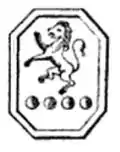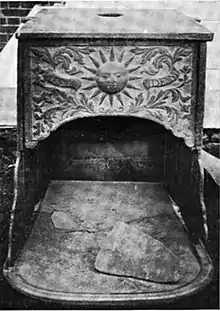Robert Grace
Robert Grace (April 25, 1709 – 1766) was an American manufacturer of cast iron items like cannons, bells, furnaces and stoves. He is known for making the Pennsylvania Fire-Place, also known as the Franklin stove. Selling the parts he manufactured for the stove was a lucrative business for Grace.
Robert Grace | |
|---|---|
| Born | April 25, 1709 |
| Died | 1766 (aged 56–57) Pennsylvania |
| Occupation | stove manufacturer |
He was a close friend of Benjamin Franklin. He once loaned Franklin some money and Franklin repaid him with the design of the Franklin stove. The mansion Grace was living in he let Franklin's scientists use part of for meetings and a collection of books. One thing led to another and ultimately his mansion became the Philadelphia Public Library.
Ancestral genealogy

Grace was a descendant of the seventeenth-century Richard Grace, whose father, also named Robert Grace, was a feudal Baron of Courtstown. His ancestors had accompanied the Earl of Pembroke in an invasion of Ireland in the later part of the 12th century. They acquired extensive lands in Kilkenny County of Ireland and the family flourished there for more than 500 years. They then lost their lands in the Glorious Revolution of 1688. Some of the Grace families followed the exiled James II of England to France and others became soldiers of fortune. Grace's father was one of the latter and eventually ended up on an estate in Barbados. In 1707 he came to Philadelphia to live for a while. During this time, Grace was born in the city on April 25, 1709. His mother died while he was a baby and his father went back to Barbados and lived out his life there. Grace was raised by his maternal grandmother. Her name was Constance and she was married to Hugh Lowden, a wealthy merchant. Grace grew up in their Philadelphia mansion on High Street.[1]
Mid life
Grace was a friend of Benjamin Franklin, who described Grace at 21 years of age in 1730 as a wealthy man with a pleasing personality. He inherited much from his father of estates in Barbados. From his grandmother's side Grace had received an inheritance from the estate of Hugh Lowden (Constance's husband). This included a large sum of money and the mansion on High Street in downtown Philadelphia in an upscale neighborhood of expensive homes. Grace was already wealthy as a young man of fourteen years of age in 1723.[2] Grace made a loan to Franklin as a friendly gesture when he was a teenager that helped him in his experiments and printing, that later was repaid in more ways than one.[3][4][5]

Franklin's Junto Club of scientists used part of Grace's mansion for their meetings. Franklin mentions in his autobiography that around 1729 the Club no longer had their meetings at a tavern and instead used a room at Grace's house that he had set aside for them. It was proposed to Franklin that books of the members should all be located in the same place for convenience of the researchers. Some of these books were collected and put on shelves in the room used for their club meetings. They were aggregated together from various members in a type of library. So many books were gathered in a year that they became unmanageable and the library was discontinued for a while. Grace's house eventually was leased by Benjamin Franklin for his residence and printing shop business. The three-story brick mansion, originally built in 1710, became the Philadelphia Public Library, eventually fulfilling Franklin's concept.[6]
The Pennsylvania Gazette newspaper published on May 29, 1740, a wedding notification that Grace had married Mrs. Rebecca Nutt, a wealthy widow, a few days prior.[7] Grace was a close friend of both Rebecca's previous husband and Franklin. Franklin invented his stove in the 1741–1742 time period; he gave a model to Grace to use as a template for manufacturing the first heating stove for the public. Grace set up a profitable casting business then making these room heaters.[8][9][10] He did not have to pay Franklin anything for the model, as Franklin wanted his stoves to be available to everyone, relishing popular appreciation of his handiwork and eschewing patents.[10][11][12] This combination of events led to the first Franklin stoves being manufactured by Warwick furnaces, which was once owned by Grace from his marriage to Rebecca and later acquired by the revolutionary war captain Samuel Van Leer.[13][14][15] Cannons and iron bells were also made at this forge factory. An iron bell that was made at Grace's forge in 1757 and used at Valley Forge in 1777 is now on display at Independence Hall in Philadelphia.[16]
The Pennsylvania Fire-Place furnace device mechanism originally had an arched and decorated front plate.[14] The stove had a projecting hearth at the bottom that was inserted into a fireplace and the smoke was guided up through the chimney.[17] The stove was more efficient in producing heat for the room far better than an open fireplace and saved wood that was used for fuel.[18][19] Grace was selling these heating stoves from a store on Market Street advertising in The Pennsylvania Gazette in 1742.[20] Franklin was advertising them as being sold by him also and printed a pamphlet about its advantages for health, comfort, and economy.[21] The furnace mechanism was portable so could be inserted into any fireplace that had a chimney.[22] The iron stove mechanism made by Grace was sold thru merchants in Philadelphia in the mid 1740s.[23]
Later life and death
Grace was in poor health in the last years of his life and died in his Philadelphia home in the summer of 1766.[24][25]
References
Citations
- James 1874, p. 376.
- Du Puy 1910, p. 65.
- Petersen, Nancy (February 25, 1990). "The Franklin stove's hometown". The Philadelphia Inquirer. Philadelphia, Pennsylvania. p. 470 – via Newspapers.com
 .
. - Aldridge 1965, p. 92.
- Bruce 1917, p. 64.
- "Lending Library". Benjamin Franklin History. Benjamin Franklin Historical Society as part of the University of Massachusetts History Club. 2014. Retrieved March 22, 2017.
- "Philadelphia". The Pennsylvania Gazette. Philadelphia, Pennsylvania. May 29, 1740. p. 3 – via Newspapers.com
 .
. - Bining 1973, p. 85.
- Kane 1997, p. 290.
- James 1874, p. 54.
- Robeson 1916, p. 154.
- Eliot 2019, p. 55.
- Jordan, John Woolf (1962). "Mother's an Engineer". Historical Society of Pennsylvania. pp. 1322–1325. ISBN 9780806352398.
- Heckscher 1992, p. 254.
- Snyder, Michael T. (March 3, 2003). "Chronicles the Coventries- Local author/historian looks North, East and South". The Mercury News.
- Osborne 1916, p. 154.
- Franklin, Benjamin (February 13, 2015). "The Franklin Stove 1742". History of Science and Technology. Retrieved April 12, 2017.
- "Franklin Stove". Encyclopedia.com. Dictionary of American History. 2000. Retrieved April 12, 2017.
This "New Pennsylvania Fireplace" avoided drafts, gave more even temperatures throughout the room, and checked loss of heat through the chimney.
- "Modern Day Cooks Versus Colonial Dames". The Terre Haute Tribune. Terra Haute, Indiana. December 28, 1958. p. 17 – via Newspapers.com
 .
. - "New Iron Fire-Places". The Pennsylvania Gazette. Philadelphia, Pennsylvania. November 11, 1742. p. 3 – via Newspapers.com
 .
. - Watson 1879, p. 132.
- Lossing 1905, p. 429.
- "The Pennsylvania Fire-Places". The Pennsylvania Gazette. Philadelphia, Pennsylvania. November 21, 1745. p. 3 – via Newspapers.com
 .
. - James 1874, p. 388.
- Mercer 1914, p. 135.
Bibliography
- Aldridge, Alfred Owen (1965). Benjamin Franklin, Philosopher & Man. Lippincott. OCLC 491560.
- Bruce, William Cabell (1917). Benjamin Franklin, Volume 2. G.P. Puttman's sons. OCLC 465667866.
- Bining, Arthur Cecil (1973). Pennsylvania iron manufacture in 18th century. ISBN 0678006784.
- Du Puy, Charles Meredith (1910). History of Dupuy Family. University of Michigan Press. OCLC 4456596.
- Eliot, Charles (2019) [1771]. The Autobiography of Benjamin Franklin. Electric Ben Franklin. The Independence Hall Association, ushistory.org. p. 55. ISBN 9780359375400.
- Heckscher, Morrison H. (January 1992). American Rococo, 1750–1775. Metropolitan Museum of Art. ISBN 978-0-87099-631-3.
- James, Mrs. Thomas Potts (1874). Memorial of Thomas Potts. University Press. p. 376. OCLC 12575016.
- Kane, Joseph Nathan (1997). Famous first facts. H.W. Wilson. ISBN 978-0-8242-0930-8.
- Lossing, Benson John (1905). Harper's Encyclopedia of United States History from 450 A.D. to 1905. Harper & brothers. OCLC 55702359.
- Mercer, Henry Chapman (1914). Bible in iron. Bucks County Historical Society. OCLC 250910450.
- Osborne, Kate Hamilton (1916). An Historical Genealogical Account of Andrew Robeson. Lippincott. OCLC 500308267.
- Robeson, Susan Stroud (1916). Genealogical of Andrew Robeson. Lippincott. OCLC 500308267.
- Watson, John Fanning (1879). Annals of Philadelphia and Pennsylvania. Parry and M'Millan. OCLC 862837935.
